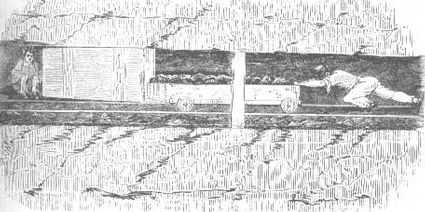Mining in the Victorian Age
Child trapper holding open the ventilation door underground to allow a tub of coal to pass by. Illustrated in the Children's Employment Commission Report, 1842
© NCMME copy photograph
© NCMME copy photograph
Compared with other jobs, working underground in a coal mine was relatively well paid. The younger children often worked as trappers, which means that they operated the doors underground. These doors directed the fresh air through the mine, so although the job was an easy one it was also vital for the miners' safety.
Trappers often sat in a hole hollowed out for them and held in their hands a string which was attached to the door. When they heard the coal wagons coming they had to open the door by pulling the string. They were mostly in the dark because candles were too expensive to be used regularly.
This was one of the simplest jobs down the mine and did not require much strength, but it was also one of the loneliest jobs and the place where the child sat was often damp and draughty. It must have been like spending twelve hours a day in a dungeon. The children never saw the daylight, except on Sunday.
Trappers often sat in a hole hollowed out for them and held in their hands a string which was attached to the door. When they heard the coal wagons coming they had to open the door by pulling the string. They were mostly in the dark because candles were too expensive to be used regularly.
This was one of the simplest jobs down the mine and did not require much strength, but it was also one of the loneliest jobs and the place where the child sat was often damp and draughty. It must have been like spending twelve hours a day in a dungeon. The children never saw the daylight, except on Sunday.


